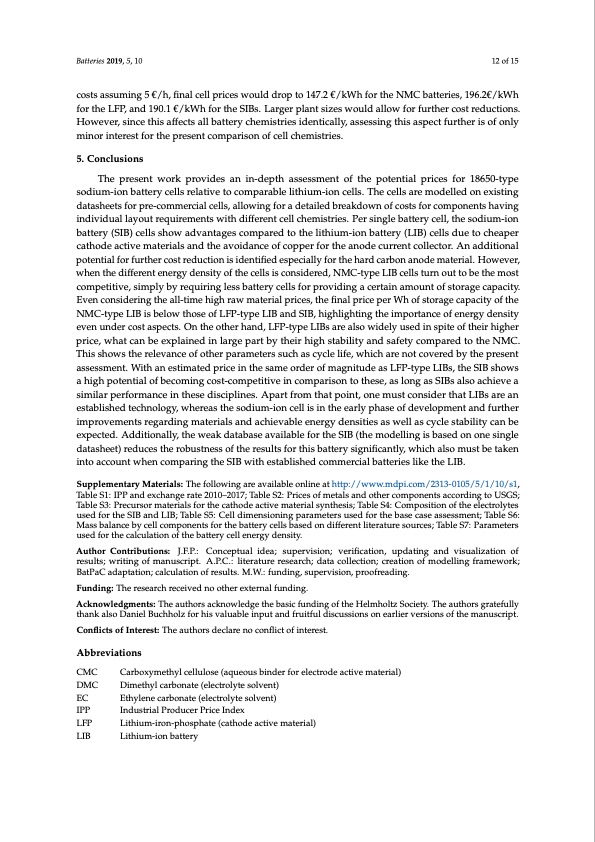
PDF Publication Title:
Text from PDF Page: 012
Batteries 2019, 5, 10 12 of 15 costs assuming 5 €/h, final cell prices would drop to 147.2 €/kWh for the NMC batteries, 196.2€/kWh for the LFP, and 190.1 €/kWh for the SIBs. Larger plant sizes would allow for further cost reductions. However, since this affects all battery chemistries identically, assessing this aspect further is of only minor interest for the present comparison of cell chemistries. 5. Conclusions The present work provides an in-depth assessment of the potential prices for 18650-type sodium-ion battery cells relative to comparable lithium-ion cells. The cells are modelled on existing datasheets for pre-commercial cells, allowing for a detailed breakdown of costs for components having individual layout requirements with different cell chemistries. Per single battery cell, the sodium-ion battery (SIB) cells show advantages compared to the lithium-ion battery (LIB) cells due to cheaper cathode active materials and the avoidance of copper for the anode current collector. An additional potential for further cost reduction is identified especially for the hard carbon anode material. However, when the different energy density of the cells is considered, NMC-type LIB cells turn out to be the most competitive, simply by requiring less battery cells for providing a certain amount of storage capacity. Even considering the all-time high raw material prices, the final price per Wh of storage capacity of the NMC-type LIB is below those of LFP-type LIB and SIB, highlighting the importance of energy density even under cost aspects. On the other hand, LFP-type LIBs are also widely used in spite of their higher price, what can be explained in large part by their high stability and safety compared to the NMC. This shows the relevance of other parameters such as cycle life, which are not covered by the present assessment. With an estimated price in the same order of magnitude as LFP-type LIBs, the SIB shows a high potential of becoming cost-competitive in comparison to these, as long as SIBs also achieve a similar performance in these disciplines. Apart from that point, one must consider that LIBs are an established technology, whereas the sodium-ion cell is in the early phase of development and further improvements regarding materials and achievable energy densities as well as cycle stability can be expected. Additionally, the weak database available for the SIB (the modelling is based on one single datasheet) reduces the robustness of the results for this battery significantly, which also must be taken into account when comparing the SIB with established commercial batteries like the LIB. Supplementary Materials: The following are available online at http://www.mdpi.com/2313-0105/5/1/10/s1, Table S1: IPP and exchange rate 2010–2017; Table S2: Prices of metals and other components according to USGS; Table S3: Precursor materials for the cathode active material synthesis; Table S4: Composition of the electrolytes used for the SIB and LIB; Table S5: Cell dimensioning parameters used for the base case assessment; Table S6: Mass balance by cell components for the battery cells based on different literature sources; Table S7: Parameters used for the calculation of the battery cell energy density. Author Contributions: J.F.P.: Conceptual idea; supervision; verification, updating and visualization of results; writing of manuscript. A.P.C.: literature research; data collection; creation of modelling framework; BatPaC adaptation; calculation of results. M.W.: funding, supervision, proofreading. Funding: The research received no other external funding. Acknowledgments: The authors acknowledge the basic funding of the Helmholtz Society. The authors gratefully thank also Daniel Buchholz for his valuable input and fruitful discussions on earlier versions of the manuscript. Conflicts of Interest: The authors declare no conflict of interest. Abbreviations CMC Carboxymethyl cellulose (aqueous binder for electrode active material) DMC Dimethyl carbonate (electrolyte solvent) EC Ethylene carbonate (electrolyte solvent) IPP Industrial Producer Price Index LFP Lithium-iron-phosphate (cathode active material) LIB Lithium-ion batteryPDF Image | Exploring the Economic Potential of Sodium-Ion Batteries

PDF Search Title:
Exploring the Economic Potential of Sodium-Ion BatteriesOriginal File Name Searched:
Exploring_the_Economic_Potential_of_Sodium-Ion_Bat.pdfDIY PDF Search: Google It | Yahoo | Bing
Salgenx Redox Flow Battery Technology: Salt water flow battery technology with low cost and great energy density that can be used for power storage and thermal storage. Let us de-risk your production using our license. Our aqueous flow battery is less cost than Tesla Megapack and available faster. Redox flow battery. No membrane needed like with Vanadium, or Bromine. Salgenx flow battery
| CONTACT TEL: 608-238-6001 Email: greg@salgenx.com | RSS | AMP |